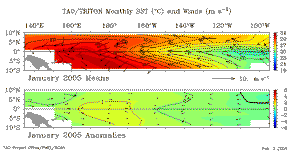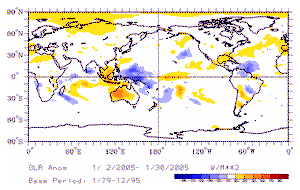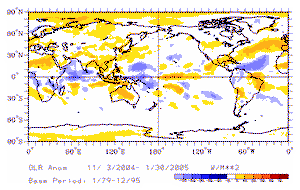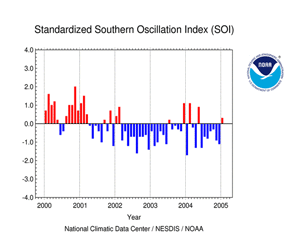ENSO WARM EVENT WEAKENS:
SST ANOMALIES DECREASE IN THE EQUATORIAL PACIFIC
SST ANOMALIES DECREASE IN THE EQUATORIAL PACIFIC
|
|
Sea-Surface
Temperatures (SSTs) and
Mixed-Layer Conditions: SSTs decreased across the entire equatorial Pacific Ocean in January, although they remained above average for the month. In the mixed-layer, above average temperatures persisted, with the largest anomalies reaching 2°C at approximately 100 m depth between 170°E and 140°W. The depth of the 20°C isotherm decreased in January, with negative anomalies developing in the western Pacific. In the central equatorial Pacific, the SST anomaly in the Niño 3.4 Index region decreased to +0.68°C (+1.22°F) above the mean. The western Pacific SST anomaly decreased as well, with a monthly averaged Niño 4 Index of +0.92°C (+1.66°F) (map of Niño regions). For the most recent ocean surface temperature conditions, please see the loop of satellite-derived weekly SST anomalies for January 2005. Above average SST anomalies have persisted throughout 2004 and into January 2005 in the western and central equatorial Pacific basin, and this can be seen in the data from NCDC's Extended Reconstructed Sea Surface Temperature dataset (ERSST version 2). Despite the decreases in the monthly averaged SSTs, the 3-month running mean of the Niño 3.4 Index remained above +0.5°C in January. (NOTE: A running 3-month mean SST anomaly above +0.5°C in the Niño 3.4 region is one indicator that an El Niño is occurring. For the official NOAA classification scheme, please see NOAA's El Niño/La Niña Index Definition and see the CPC ENSO Diagnostic Discussion for NOAA's latest official assessment of ENSO conditions.) |
|
|
Equatorial
Zonal Winds (U-Component Winds) and Sea-Level
Topography: The easterly trade winds were above normal across much of the eastern and central equatorial Pacific basin during January, with westerly wind anomalies developing in the western Pacific during the month. The observed easterly trade-wind anomalies increased equatorial upwelling in the mixed-layer, which led to the observed decreases in the monthly averaged SST anomalies in the Niño regions. Satellite altimetry of ocean surface topography from the NASA/JPL Jason-1 satellite over the Pacific basin and global oceans is shown to the left. The anomalous westerly wind activity in the western Pacific did not generate another oceanic Kelvin wave in the mixed-layer by the end of January. The most recent Pacific overpass of the Jason-1 satellite shows no significant, large-scale positive or negative sea level anomalies in the equatorial Pacific at the end of the month (see the 23 January 2005 overpass). |
|
|
Outgoing
Longwave Radiation (OLR): The map to the left shows the spatial pattern of global OLR (in W m-2) observed by satellite during January. In general, the majority of the central equatorial Pacific region had positive OLR anomalies with respect to the 1979-1995 base period during January. The 3-month averaged OLR anomalies were positive or near-normal along the Equator, from the dateline to the South American coast. The one region that had enhanced convection was the western Pacific region, where large-scale tropical convection and several tropical cyclones have occurred. The monthly-averaged OLR Index value remained positive in January, with a value of +0.2 W m-2 averaged across an area centered over the dateline in the western Pacific between 160° E and 160° W. The recent shift in sign of the OLR Index from a negative value in November to positive one in December reflected the lack of persistence in the index in 2004, during which it shifted sign numerous times. The January positive index value reflected the change that occurred in late 2004. Therefore, the convective response of the atmosphere to the above normal SST anomalies in the western and central equatorial Pacific has been limited, since the OLR Index has shown no consistent trend during the 2004-2005 El Niño. Note that high frequency variability in OLR is typically associated with the Madden-Julian Oscillation (MJO) (MJO related convective activity propagates west to east in the near-equatorial region from the Indian Ocean into the Pacific Ocean approximately every 30-60 days). The latest MJO activity can be seen in CPC's graphs of Daily MJO Indices. |
| Southern
Oscillation Index (SOI): The standardized SOI switched signs from negative to positive in January, with an average index value of +0.3 for the month. This switch in sign followed seven consecutive months during which the SOI had remained negative (note that negative SOI values are consistent with El Niño conditions). The trend in SOI during the latter half of 2004 fluctuated several times between a near-neutral value and a more negative index associated with warm event conditions. The observed fluctuations in the SOI during 2004, combined with the recent change in sign to a positive value in January, suggests that the atmosphere never fully responded to the above average SSTs during this weak El Niño event. Given that the El Niño conditions in the equatorial Pacific weakened further in January, it appears that the current warm event peaked during November and December 2004. Therefore, the 2004-2005 El Niño has begun to diminish, and ENSO conditions were approaching near-neutral at the end of January given all of the observed changes in atmospheric and oceanic indices. |
Additional Links
- ENSO Monitoring
- NOAA El Niño / La Niña Index Definition
- NOAA's Pacific Marine Environmental Laboratory (PMEL):
- NOAA's Climate Prediction Center (CPC):
- NOAA's Physical Science Laboratory
- NASA/JPL Ocean Surface Topography from Space
- Australian Bureau of Meteorology (BoM) Climate Driver Update
- IRI - International Research Institute
 NOAA's National Centers for Environmental Information
NOAA's National Centers for Environmental Information




 Larger image of
January OLR
Larger image of
January OLR Larger image
of Nov-Jan OLR
Larger image
of Nov-Jan OLR Larger image of
January OLR Index
Larger image of
January OLR Index